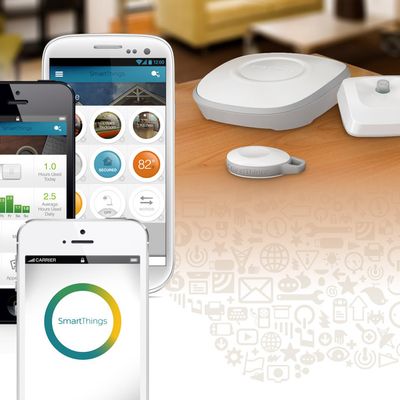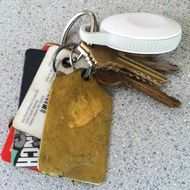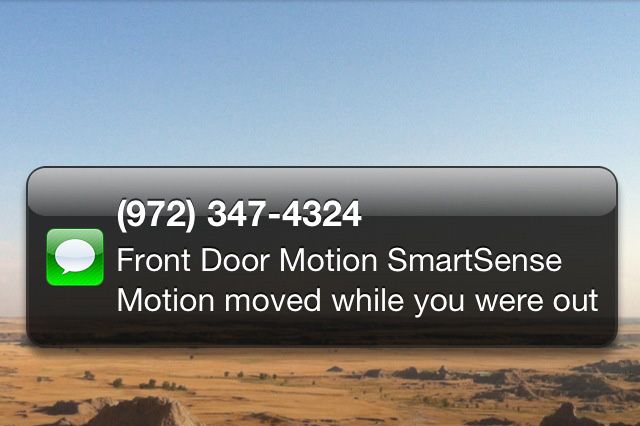
Imagine coming home after work. Your door unlocks as it senses you approaching. When you step inside, the lights come on and the thermostat adjusts to the perfect temperature. If you’ve reached your fitness goals for the day, your TV turns on and a machine pours you a glass of whiskey. If you haven’t, your stereo plays “Eye of the Tiger,” prompting you to get dressed for the gym. Hours later, when you climb into bed, your door locks automatically and soothing ocean sounds play; when you wake up the next morning, your coffeemaker starts brewing.
This sounds like a Jetsons plot premise, but it’s what we’ve been promised by futurists in Silicon Valley for years. They call it “the Internet of Things” — a system where every object is connected to every other object via the Internet — and until recently, it was a kind of amorphous geek fantasy, reserved in practice for early adopters and the ultrarich. (Bill Gates has had such a system installed in his mansion for years.) For normal people, though, the Internet of Things has been slow to arrive.
So when a company called SmartThings offered to send me a kit that would help me connect all of the devices in my home, I was skeptical. Why would I need this? How would it help me?
But after a week of testing it, I’m convinced the Internet of Things is almost here. And it could be huge.
SmartThings CEO Alex Hawkinson describes his creation as a sort of centralized brain for your everyday devices. He came up with the idea after a burst water pipe in his vacation home that went unnoticed for a month left him with $80,000 in water damage. Why wasn’t there a moisture sensor, he thought, that could send him a text whenever it detected the presence of water? And moreover, why couldn’t he use his phone to control the locks on his doors, the lights on his porch, or the sprinklers on his lawn?
SmartThings raised $1.2 million via a wildly successful Kickstarter campaign, and expanded into a cornucopia of different kinds of sensors, all of which speak a common language and can send information back to a central hub. At present, SmartThings ships with motion sensors, GPS presence sensors, smart electric outlets, and multi-sensors that can detect vibration, temperature, and the relative position of two separate parts (to tell whether a door is open or closed, for example). And since SmartThings is an open-source platform that anyone can build on, there will be many more devices connected to the system in time, all of which can be used in programming sequences. (These third-party devices range from serious to silly — Hawkinson told me about a user’s customized shot machine, which pours shots of different kinds of liquor depending on which sports team wins a given game.)
The basic technology underlying SmartThings exists already. Phillips makes an app-controlled lightbulb; Belkin sells several Internet-compatible gadgets that can be controlled with smartphones; and a start-up called Tile is making a device that attaches to your keys or wallet and beeps whenever a button on a smartphone app is pressed, making them easy to find. SmartThings (like its competitors, including ioBridge and NinjaBlocks) wants to be the bridge that brings these gizmos together onto one giant network.
“There’s a fairly big problem where there are thousands of compatible devices being created, and nothing tying them together,” Hawkinson told me. “Our goal is to be the thing that connects them all.”
After unboxing my SmartThings kit, I put a presence sensor — a little ovular white thing — on my keychain, solving my habitual key-losing problem once and for all. Next, I put motion sensors in my bedroom and my home office, multi-sensors on my front door and in my car’s glove box, a smart outlet on my bedside lamp, and another presence sensor on my dog’s collar. The next hour was spent picking various “SmartApps” for these devices, all of which amounted to simple if-X-then-Y chains of commands. (In my first wave, I set it so that I would get a text message if my dog wandered outside a specified area around my house or my car moved from its spot, so that my lamp would turn off whenever I left the bedroom for more than five minutes, and so that I’d get a notification if my front door were opened between midnight and 6 a.m.) All of this was relatively easy to do with SmartThings’ iPhone app, which assigns an icon to each connected gadget, then allows you to configure them as you see fit.

One problem with SmartThings is that it can only control appliances that don’t require an extra step or button push to work once they’re turned on. It can turn a switched outlet on and off, but it can’t start a wash cycle, make a microwave heat up food, or take a video game system to its home screen. I don’t have a smart thermostat or a Wi-Fi-enabled lock, so I was mostly limited to turning lamps off and on. This isn’t SmartThings’ fault – it would work better if more appliances supported wireless connectivity – but it’s a drawback nonetheless.
It should be said that there is a certain Rube Goldberg quality to the Internet of Things. At various points, it occurred to me that instead of pressing an icon on my iPhone to send a signal to the SmartThings hub in my office, which would in turn send a signal to a smart outlet to turn off the lamp next to my bed, I could just, you know, reach over and turn off the damn lamp.

The frivolity factor was exacerbated when the SmartThings team briefly let me play around with their IFTTT (“if this, then that”) channel, a way for SmartThings to connect with Gmail, Facebook, and a litany of other web services. (The channel is still in private beta, but will be available to all users soon.) In theory, you could use IFTTT and SmartThings to trigger all sorts of cool processes. In practice, I set up a recipe that automatically tweeted “Good morning!” whenever I sat down at my computer, and another recipe that lit up my desk lamp whenever I received a new Gmail message — both good party tricks, but not exactly world-changers.
And at times, my connected house created more problems than it solved. Once, during a trip out of town, a motion sensor I’d placed outside my front door lit up my phone with dozens of “Activity Detected” text messages over the course of several hours. It was probably a squirrel or a swaying branch, but I freaked out, and came to the harrowing conclusion that I had been targeted by a band of very slow-working burglars.

However, I couldn’t deny that SmartThings solved several small, annoying problems. Within an hour, I’d gotten a simple security system for my front door, made sure I’d never forget to turn off the light or lose my keys, and created a way to keep my dog from running away — all well worth the $199 price of a basic kit.
Hawkinson and other Internet of Things boosters speak mostly in the future tense. One day, they say, your refrigerator will tell your computer to place a FreshDirect order for more milk when it detects you’re running low, you’ll be able to control your lawn sprinklers from anywhere in the world, and you’ll never lose the remote again.
All of this is probably true, and SmartThings feels like a good first step in that inevitable direction. Most major appliance manufacturers are dipping their toes in the Internet of Things, and Hawkinson says that 1,500 SmartThings users are currently making their own devices that will work on the company’s platform, meaning that everything from gumball machines to shoe trees could ultimately be part of a wired home.
“The big picture is that you have all the objects in the world becoming connected,” Hawkinson told me. “You can control the way the world works with software. You can take dumb stuff and make it smart.”
That’s an exciting vision. It’s also slightly creepy. Even in the course of my five-day experiment with SmartThings, my house started to feel a bit like a set from The Truman Show. With so much of your daily routine outsourced to apps and gadgets, you start to have the strange sense of being a passive actor in your own life, mindlessly tripping sensors and watching the effects unfold — not to mention the privacy concerns associated with a device that keeps track of literally every step you take.
Still, if SmartThings is the future, I’ll take it over the alternative. As long as they get that shot-pouring machine working.





























